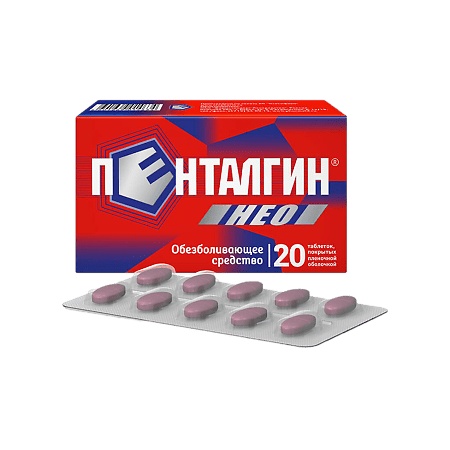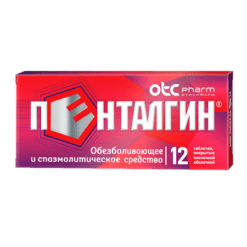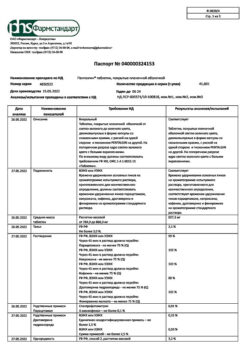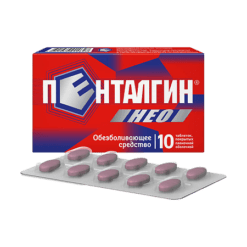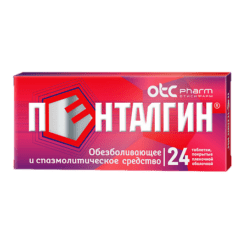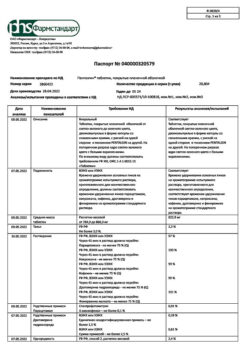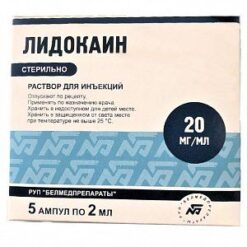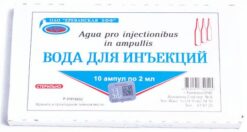No products in the cart.
Pentalgin Neo, 50 mg+220 mg+325 mg 20 pcs.
€7.85 €6.87
EAN: 4601669014634
SKU: 497894
Categories: Anesthesia and resuscitation, Local anesthetics, Medicine
Description
Pharmacotherapeutic group: combined analgesic (non-steroidal anti-inflammatory agent + analgesic non-narcotic agent + psychostimulant).
ATX code: N02BE71
Pharmacological properties
Pharmacodynamics:
Naproxen: non-steroidal anti-inflammatory agent, has analgesic, antipyretic and anti-inflammatory effects. The mechanism of action is due to non-selective inhibition of cyclooxygenase-1 and -2 (COX-1, COX-2) activity, which regulates the synthesis of prostaglandins. The use of naproxen in the form of sodium naproxen salt provides faster absorption and rapid onset of analgesic effect.
Paracetamol: non-narcotic analgesic, has antipyretic and analgesic effect caused by blockade of cyclooxygenase in the central nervous system and effects on the centers of pain and thermoregulation.
Caffeine: decreases sleepiness and fatigue, increases mental and physical performance; it dilates blood vessels of skeletal muscles, heart and kidneys and decreases platelet aggregation. In this combination, caffeine at a low dose has almost no simulative effect on the central nervous system, increases the tone of cerebral vessels and helps accelerate blood flow. Caffeine increases permeability of histohematic barriers and increases bioavailability of non-narcotic analgesics and decreases COX activity, as it is an antagonist of adenosine A(2A) and A(2B) receptors, which helps to increase analgesic effect.
In a registrational clinical study of the drug Pentalgin® NEO the superiority in terms of the effect on overall pain relief (TOTPAR score) compared to naproxen monodrug and to the combined drug of paracetamol and caffeine has been confirmed.
Pharmacokinetics
Naproxen: is rapidly and completely absorbed from the gastrointestinal tract (GIT). Bioavailability is 95% (eating has almost no effect on the completeness or speed of absorption). Time to reach maximum blood concentration (Tmax) is 1-2 hours. Blood plasma protein binding > 99 %. The elimination half-life (T1/2) is 12-15 hours. Metabolism occurs in the liver to dimethylnaproxen with participation of CYP2C9 isoenzyme. Clearance is 0.13 ml/min/kg. Excreted by the kidneys is 98%, 10% is excreted unchanged, 0.5-2.5% is excreted in the bile. Equilibrium concentration in blood plasma is determined after 4-5 doses of the drug (2-3 days).
Paracetamol: easily absorbed in the gastrointestinal tract, the StaX is reached after 0.5-2 hours and is 5-20 mcg/ml, plasma protein binding – 15%. It penetrates the blood-brain barrier. Paracetamol is metabolized in the liver and excreted by the kidneys, mainly as glucuronides and sulfate conjugates. Less than 5% of paracetamol is excreted unchanged. T1/2 varies from 1 to 4 h.
Caffeine: completely and rapidly absorbed in the gastrointestinal tract, the Stax is reached in 50-75 minutes and is 1.58-1.76 mg/L. It is rapidly distributed in all organs and tissues of the body and easily passes through the blood-brain barrier and the placenta. Binding with blood proteins is 25-36%. More than 90% is metabolized in the liver. T1/2 in adults is 3.9-5.3 hours (sometimes up to 10 hours) Excretion of caffeine and its metabolites is done by kidneys (1-2% of adults excrete unchanged).
Indications
Indications
Pain syndrome of various origins:
for diseases of the musculoskeletal system (osteoarthrosis of peripheral joints and spine, including radicular syndrome, arthritis, myalgia);
neuralgia;
toothache;
headache, migraine;
algodismenorrhea;
post-traumatic (sprains and bruises) and postoperative pain syndrome accompanied by inflammation.
The drug Pentalgin® NEO is used for symptomatic therapy (to reduce pain and inflammation) and does not affect the progression of the underlying disease.
Pharmacological effect
Pharmacological effect
Pharmacotherapeutic group: combined analgesic (non-steroidal anti-inflammatory drug + analgesic non-narcotic drug + psychostimulant).
ATX code: N02BE71
Pharmacological properties
Pharmacodynamics:
Naproxen: a non-steroidal anti-inflammatory drug, has analgesic, antipyretic and anti-inflammatory effects. The mechanism of action is due to non-selective inhibition of the activity of cyclooxygenase-1 and -2 (COX-1, COX-2), which regulates the synthesis of prostaglandins. The use of naproxen in the form of naproxen sodium salt provides faster absorption and rapid onset of analgesic effect.
Paracetamol: a non-narcotic analgesic, has an antipyretic and analgesic effect due to the blockade of cyclooxygenase in the central nervous system and its effect on the centers of pain and thermoregulation.
Caffeine: reduces drowsiness, fatigue, increases mental and physical performance; dilates blood vessels of skeletal muscles, heart, kidneys, reduces platelet aggregation. In this combination, caffeine in a small dose has virtually no simulating effect on the central nervous system, increases the tone of cerebral vessels and helps accelerate blood flow. Caffeine increases the permeability of histohematic barriers and increases the bioavailability of non-narcotic analgesics, and also reduces the activity of COX, because is an antagonist of adenosine A(2A) and A(2B) receptors, which enhances the analgesic effect of analgesics.
In a registration clinical trial of the drug Pentalgin® NEO, the superiority in the effect on overall pain relief (TOTPAR indicator) over the single drug naproxen and over the combined drug of paracetamol and caffeine was confirmed.
Pharmacokinetics
Naproxen: quickly and completely absorbed from the gastrointestinal tract (GIT). Bioavailability – 95% (food intake has virtually no effect on either the completeness or the rate of absorption). The time to reach maximum concentration in the blood (Tmax) is 1-2 hours. Plasma protein binding > 99%. The half-life (T1/2) is 12-15 hours. Metabolism occurs in the liver to dimethylnaproxen with the participation of the CYP2C9 isoenzyme. Clearance – 0.13 ml/min/kg. 98% is excreted by the kidneys, 10% is excreted unchanged, with bile – 0.5-2.5%. The equilibrium concentration in the blood plasma is determined after taking 4-5 doses of the drug (2-3 days).
Paracetamol: easily absorbed from the gastrointestinal tract, Cmax is reached after 0.5-2 hours and is 5-20 mcg/ml, binding to plasma proteins is 15%. Penetrates the blood-brain barrier. Paracetamol is metabolized in the liver and excreted by the kidneys, mainly in the form of glucuronides and sulfate conjugates. Less than 5% of paracetamol is excreted unchanged. T1/2 varies from 1 to 4 hours.
Caffeine: is completely and quickly absorbed into the gastrointestinal tract, Cmax is reached in 50-75 minutes and is 1.58-1.76 mg/l. It is quickly distributed in all organs and tissues of the body, easily penetrates the blood-brain barrier and the placenta. Communication with blood proteins -25-36%. More than 90% is metabolized in the liver. T1/2 in adults is 3.9-5.3 hours (sometimes up to 10 hours). Caffeine and its metabolites are excreted by the kidneys (1-2% is excreted unchanged in adults).
Special instructions
Special instructions
General
Do not exceed the doses specified in the instructions. To reduce the risk of adverse events, the minimum effective dose should be used for the shortest possible short course.
If pain persists or worsens during therapy, you should consult a doctor.
With prolonged use of the drug, monitoring of peripheral blood and the functional state of the liver is necessary.
The drug should not be taken together with other anti-inflammatory and painkillers, except as prescribed by a doctor.
The drug should be avoided within 48 hours before surgery. If it is necessary to determine 17-corticosteroids, the drug should be discontinued 48 hours before the study. Similarly, naproxen may affect the determination of 5-hydroxyindoleacetic acid in urine.
The use of naproxen, like other drugs that block prostaglandin synthesis, may affect fertility and is therefore not recommended for women planning pregnancy.
During treatment, you should avoid drinking alcoholic beverages (see Section “Drug Interactions”).
When using the drug, you should limit your consumption of products containing caffeine, since excess caffeine intake can lead to nervousness, irritability, insomnia and, in some cases, increased heart rate.
Effect on laboratory parameters
The use of paracetamol may affect the results of determining uric acid using the phosphotungstic acid method and glycemia using the glucose oxidase/peroxidase method.
Caffeine may interfere with dipyridamole test results; During the study, it is necessary to refrain from taking caffeine for 8-12 hours.
Each tablet of the drug contains approximately 20 mg of sodium. When limiting salt intake, this must be taken into account.
Impact on the ability to drive vehicles and machinery
Naproxen and caffeine, which are part of the drug, may affect the speed of the psychomotor reaction, so during the period of administration, caution should be exercised when driving a car and performing tasks that require increased attention.
Active ingredient
Active ingredient
Caffeine, Naproxen, Paracetamol
Composition
Composition
Active ingredients:
paracetamol – 325.0 mg,
naproxen sodium – 220.0 mg,
caffeine anhydrous – 50.0 mg.
Excipients:
microcrystalline cellulose (microcrystalline cellulose 101) – 175.50 mg,
povidone (medium molecular weight polyvinylpyrrolidone, povidone K-30) – 36.00 mg,
croscarmellose (croscarmellose sodium) – 34.00 mg,
potato starch – 30.00 mg,
talc – 18.00 mg,
magnesium stearate – 7.00 mg,
colloidal silicon dioxide – 4.50 mg.
Shell: Opadry 13A200004 PURPLE – 30,000 mg [Hypromellose-2910 (hydroxypropyl methylcellulose-2910) – 14,604 mg, talc – 5,061 mg, povidone – 4,644 mg, titanium dioxide – 2,925 mg, polysorbate-80 – 1,320 mg, dye carmine red (carmine 50%) – 1.167 mg, indigo carmine aluminum varnish (blue 2) – 0.279 mg].
Pregnancy
Pregnancy
The use of Pentalgin® NEO is contraindicated during pregnancy and breastfeeding.
Contraindications
Contraindications
Hypersensitivity to naproxen, naproxen sodium, other non-steroidal anti-inflammatory drugs (NSAIDs), or xanthines; hypersensitivity to other components of the drug;
complete or incomplete combination of bronchial asthma, recurrent polyposis of the nose or paranasal sinuses and intolerance to acetylsalicylic acid and other NSAIDs (including a history);
period after coronary artery bypass surgery;
erosive and ulcerative lesions of the gastrointestinal tract (in the acute phase), active gastrointestinal bleeding;
hemophilia and other bleeding disorders and hemostasis disorders;
cerebrovascular bleeding or other bleeding;
decompensated heart failure;
organic diseases of the cardiovascular system (acute myocardial infarction, severe coronary heart disease, severe arterial hypertension), paroxysmal tachycardia, frequent ventricular extrasystole;
severe liver failure or active liver disease;
severe renal failure (creatinine clearance (CC) less than 30 ml/min), progressive kidney disease, confirmed hyperkalemia;
increased excitability, sleep disturbances, anxiety disorders (agoraphobia, panic disorders);
pregnancy, breastfeeding period;
children under 18 years of age.
With caution
Coronary heart disease, cerebrovascular diseases, congestive heart failure, dyslipidemia/hyperlipidemia, diabetes mellitus, mild to moderate liver failure with increased transaminase levels, benign hyperbilirubinemia (including Gilbert’s syndrome, alcoholic liver damage), peripheral arterial disease, smoking, glaucoma, impaired renal function (creatinine clearance 30-60 ml/min), a history of ulcerative lesions of the gastrointestinal tract, the presence of Helicobacter pylori infection, deficiency of glucose-6-phosphate dehydrogenase; epilepsy and a tendency to seizures, old age, systemic lupus erythematosus or mixed connective tissue diseases (Sharpe’s syndrome), long-term use of NSAIDs, frequent alcohol consumption, severe somatic diseases, concomitant therapy with the following drugs: anticoagulants, antiplatelet agents, oral glucocorticoids, selective serotonin reuptake inhibitors. If you have one of the listed diseases/conditions, be sure to consult your doctor before taking the drug.
Side Effects
Side Effects
Undesirable effects that may develop during treatment with Pentalgin® NEO are classified according to the following frequency of occurrence:
very common (> 1/10), common (≥ 1/100 to < 1/10), uncommon (≥ 1/1,000 to < 1/100), rare (≥ 1/10,000 to < 1/1,000), very rare (< 1/10,000), frequency unknown (cannot be determined from available data).
Blood and lymphatic system disorders:
uncommon: eosinophilia, granulocytopenia, leukopenia, thrombocytopenia; very rarely – methemoglobinemia, hemolytic anemia.
Nervous system disorders:
often: headache, vertigo, dizziness, drowsiness; uncommon: tremor, paresthesia, headache, depression, sleep disturbances, attention disorder, insomnia, malaise.
Mental disorders:
often: nervousness; uncommon: insomnia; rarely: anxiety, euphoric mood, internal tension.
Visual disorders:
often: visual impairment.
Hearing and labyrinthine disorders:
often: tinnitus, hearing loss; uncommon: hearing loss.
Cardiac disorders:
often: swelling, palpitations; uncommon: congestive heart failure, tachycardia, arrhythmia; frequency unknown – increased blood pressure.
Disorders of the respiratory system, chest and mediastinal organs:
often: shortness of breath; uncommon: eosinophilic pneumonia; very rarely: bronchospasm (in patients with hypersensitivity to acetylsalicylic acid and other NSAIDs).
Gastrointestinal disorders:
often: constipation, abdominal pain, dyspepsia, nausea, diarrhea, stomatitis, flatulence; uncommon: gastrointestinal bleeding and/or gastric perforation, hematemesis, melena, vomiting; dry mouth; very rarely: relapse or exacerbation of ulcerative colitis or Crohn’s disease; frequency unknown: gastritis.
Liver and biliary tract disorders:
uncommon: increased activity of liver enzymes, jaundice; very rare: liver dysfunction.
Skin and subcutaneous tissue disorders:
often: skin itching, skin rash, ecchymosis, purpura; uncommon: alopecia, photodermatoses; very rare: bullous reactions, including Stevens-Johnson syndrome and toxic epidermal necrolysis.
Musculoskeletal and connective tissue disorders:
uncommon: myalgia and muscle weakness.
Renal and urinary tract disorders:
uncommon: glomerulonephritis, hematuria, interstitial nephritis, nephrotic syndrome, renal failure, renal papillary necrosis.
General disorders and disorders at the injection site:
often: thirst, increased sweating; uncommon: hypersensitivity reactions, menstrual irregularities, hyperthermia (chills and fever).
There is no data on an increase or expansion of the range of adverse effects of individual components when used as part of a combination in accordance with the instructions for medical use.
If side effects occur, you should consult a doctor.
Interaction
Interaction
Other NSAIDs, including selective cyclooxygenase-2 inhibitors, corticosteroids: increased risk of naproxen side effects from the gastrointestinal tract.
Propranolol and other beta blockers: Naproxen may reduce the antihypertensive effect of the drugs. Caffeine may inhibit the therapeutic effects of beta blockers.
Cardiac glycosides: caffeine accelerates absorption and enhances the effect of cardiac glycosides, increasing their toxicity.
Diuretics: Naproxen may reduce the diuretic effect of diuretics and inhibit the natriuretic effect of furosemide. Diuretics may increase the risk of NSAID nephrotoxicity.
Lithium: Naproxen reduces the excretion of lithium, resulting in increased plasma lithium concentrations.
Myelotoxic drugs: increased hematotoxicity of naproxen.
Cyclosporine: increased risk of renal failure.
Probenecid: increases the plasma concentration of naproxen.
Methotrexate, phenythion, sulfonamide: naproxen slows their excretion, which increases the risk of their toxic effects.
Antacids containing magnesium and aluminum: decreased absorption of naproxen.
Anticoagulants: naproxen can enhance the effect of anticoagulants; paracetamol, with prolonged use, enhances the effect of indirect anticoagulants.
Antiplatelet drugs, selective serotonin reuptake inhibitors: increased risk of gastrointestinal bleeding.
Mifepristone: Concomitant use of NSAIDs is not recommended for 8-12 days after using mifepristone.
Tacrolimus: Concomitant use of NSAIDs increases the risk of nephrotoxicity.
Diflunisal: increased plasma concentrations of paracetamol, which increases the risk of hepatotoxicity.
Inducers of microsomal liver enzymes: may increase the hepatotoxic effect of paracetamol.
Inhibitors of microsomal liver enzymes: reducing the risk of hepatotoxicity of paracetamol.
Chloramphenicol: Paracetamol increases the elimination time of chloramphenicol.
Metoclopramide, domperidone: increase the rate of absorption of paracetamol.
Cholestyramine: decreased rate of absorption of paracetamol.
Theophylline: Caffeine reduces the excretion of theophylline.
Barbiturates, primidone, anticonvulsants: may increase metabolism and increase clearance of caffeine.
Cimetidine, oral contraceptives, disulfiram, ciprofloxacin, norfloxacin: the metabolism of caffeine in the liver may decrease (slowing its elimination and increasing its concentration in the blood).
Calcium supplements: caffeine reduces their absorption in the gastrointestinal tract.
Narcotic and sleeping pills: caffeine reduces their effectiveness.
Alcohol: increased risk of liver damage and acute pancreatitis.
Overdose
Overdose
Symptoms: drowsiness, dyspeptic disorders (heartburn, nausea, vomiting, abdominal pain), headache, tinnitus, weakness, sweating, pale skin, anxiety, agitation, restlessness, anorexia, confusion, tachycardia, arrhythmia, hyperthermia, tremor or muscle twitching; in severe cases – hematemesis, melena, impaired consciousness, convulsions, renal and/or liver failure.
If you suspect an overdose of the drug, you should immediately seek medical help.
Treatment. The victim should undergo gastric lavage and be prescribed enterosorbents (activated carbon). The need for additional therapeutic measures is determined depending on the severity of the condition and the severity of symptoms of intoxication.
Storage conditions
Storage conditions
Store in a dry place at a temperature not exceeding 25 °C in the original packaging (blister in a pack).
Keep out of the reach of children.
Shelf life
Shelf life
2 years. Do not use after the expiration date stated on the package.
Manufacturer
Manufacturer
Pharmstandard-Leksredstva, Russia
Additional information
| Shelf life | 2 years. Do not use after the expiration date stated on the package. |
|---|---|
| Conditions of storage | Store in a dry place at a temperature not exceeding 25 ° C in the original package (blister in the package). Keep out of reach of children. |
| Manufacturer | Pharmstandard-Leksredstva, Russia |
| Medication form | pills |
| Brand | Pharmstandard-Leksredstva |
Other forms…
Related products
Buy Pentalgin Neo, 50 mg+220 mg+325 mg 20 pcs. with delivery to USA, UK, Europe and over 120 other countries.

